
Your hot tub’s low water volume level, high temperature and intense bather load causes all sorts of challenges in keeping the water clear and bacteria free. It’s therefore vital that you use a sanitizer as it will attack the bacteria and purify the water keeping it safe for bathing in. But which is the best hot tub sanitizer? There seem to be so many different types on the market all claiming to keep the water the cleanest for the longest with the least maintenance. Trying to decide upon the best hot tub sanitizer for your own particular needs can be a confusing task. I decided to investigate and to simplify the options as much as possible to help you decide which sanitization system to go for in your hot tub.
So, which is the best sanitizer for hot tubs? It really depends on your priorities as most hot tub sanitizers do a good job but they will have a number of drawbacks as well. One of the best-balanced solutions is to use a chlorine-based sanitizer to do all of the heavy lifting and to use this in conjunction with a mineral-based sanitizer. The mineral-based sanitizer is the most natural and is best for the environment and using it will minimize the amount of chlorine you need to use. Chlorine or bromine are the most effective at killing bacteria but their use comes with a number of potential side effects.
Hot tub sanitizer alternatives
So, I basically want my hot tub to be clean, healthy and hygienic, I want the sanitizer system I use to be relatively cost-effective, as good for the environment as it can be and also to be as low maintenance as possible. Broadly speaking these criteria are in order of importance to me and I suspect that many people will have a similar set of ideals. You would hope that it would be as simple as just adding chlorine and letting the hot tub get on with it but unfortunately, there is a large number of options and variations, all of which can soon start to look very confusing. Add to this the fact that a number of “miracle” hot tub sanitizers are being marketed as being the ultimate all-round solution and it soon becomes really hard to see the wood for the trees!
Do I have to use chlorine/bromine in my hot tub?
The first big question is as to whether you still need to run a hot tub using the good old fashioned and well-tested chlorine or bromine solutions. Both chlorine and bromine are really good disinfectants and do a great job of keeping the water clear but they do come with a number of drawbacks. One of the main issues that they both smell and can cause skin irritation, irritation to the eyes as well as some possible respiratory problems. These are heavyweight chemicals and aren’t to be messed with, you need to make sure that you follow the instructions to the letter and regular maintenance is a must. The other issue is that to be honest, in a chlorine or bromine sanitized hot tub you are basically sitting in a chemical stew. This can’t be great for our health or the environment and just seems to not be the right thing to be doing in this day and age. Surely there are some more natural alternatives?
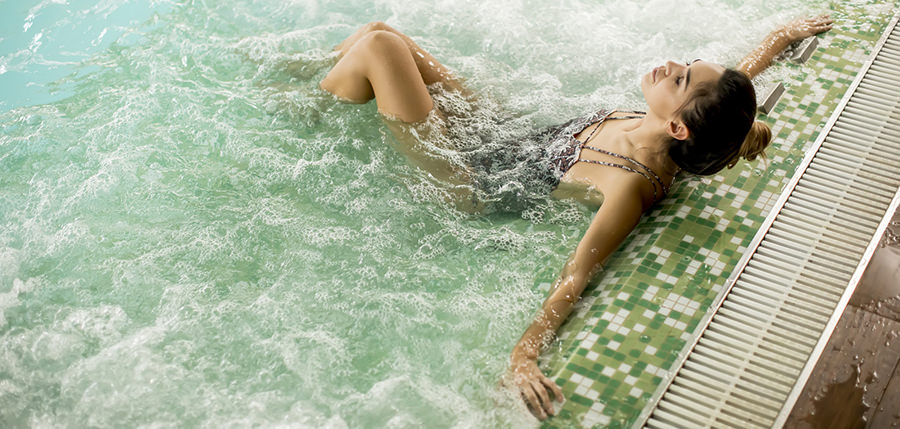
Non-chlorine hot tub options
It’s important to note that the Centre for Disease Control and Prevention only recommend either chlorine or bromine are being suitable for or sanitizing hot tubs. They describe chlorine and bromine as “primary sanitizers” whereas other options are described as “secondary sanitizers” The point is that a secondary sanitizer can be used and is perfectly effective but it will probably need be used in conjunction with one of the primary sanitizers. This means that if you are using a secondary sanitizer it will probably need to be boosted with some form of chlorine or bromine at some point.
However, the Centre for Disease Control and Prevention is basically concerned with public health and so is really referring to hot tubs that are used in public places such as spas and hotels. Obviously, this type of hot tub is going to get significantly more intense use than the average hot tub in someone’s back garden. This rather filled me with hope in that in a moderately used hot tub, a so-called secondary sanitizer might be all that is needed hopefully with very limited use of chlorine or bromine to either shock or just boost the sanitization process periodically.
So what are this non – chlorine or bromine sanitizers and are they really a more natural alternative?
Mineral sanitizers – A mineral sanitizer is a much more eco-friendly and natural way to keep your hot tub water fresh and clean. Mineral sanitizer uses copper, silver and other minerals to kill the bacteria in the water and it can be very effective although it sometimes is a bit slow to get started. Mineral sanitizers are also reasonably cost-effective and easy to use. However, you may well need to use some chlorine alongside the mineral sanitizer particularly at the beginning before it has started working. A little chlorine will also help keep the water smelling fresher because it can start to smell a bit stale if you use a mineral sanitizer alone.
Mineral sanitizers are becoming increasingly popular and they do offer a really good cost-effective and relatively environmentally friendly solution. My only concern with changing to this system is that it might not 100-percent keeping the water clean as it could do and that I would still need to use chlorine. However, with a little bit of further research, I realised that it would be possible to use a non-chlorine bass shock in combination with a mineral sanitizer and this might well be a good solution. The combination of a mineral sanitizer and an ozonator is also a really strong possibility as the two of them in combination will do a better job and they work well together to kill the bacteria. Using this combination with a non-chlorine shock could well be the best solution to having a hot tub of that doesn’t use strong chemicals such as chlorine or bromine. Non chlorine shock doesn’t smell, is tolerant of a wide range of PH levels and doesn’t change the PH level when added to water. You can also get into the tub straight away after using it as well.
Let’s look at ozonators now….
Ozonators – Ozonators inject a tiny amount of Ozone into the water which then kills the bacteria. This is a highly effective way of sanitizing your hot tub and also comes without any side effects, smell or skin irritation. It’s also relatively maintenance-free which means that you don’t have to worry too much about it. The downside is that it can be relatively expensive to set up an ozonator and you might want to get an ozonator that is actually integral to your hot tub. This means that there will be some fitting and possibly some servicing fees to pay to get started with your ozonator. However, once it is up and running you will save on buying traditional chemicals such as chlorine or bromine and they are very economical to run.
So, the combination of an ozonator with a mineral sanitization system looks, on the face of it, to be possibly the best of both worlds. Both systems are relatively maintenance-free, they don’t come with any side effects of smell or irritation and they are both relatively environmentally friendly. There is obviously a setup cost involved but this should be recouped over time as you won’t have to buy expensive chlorine or bromine anymore. Bear in mind though that you will need to shock the tub occasionally using preferably a non-chlorine shock treatment.
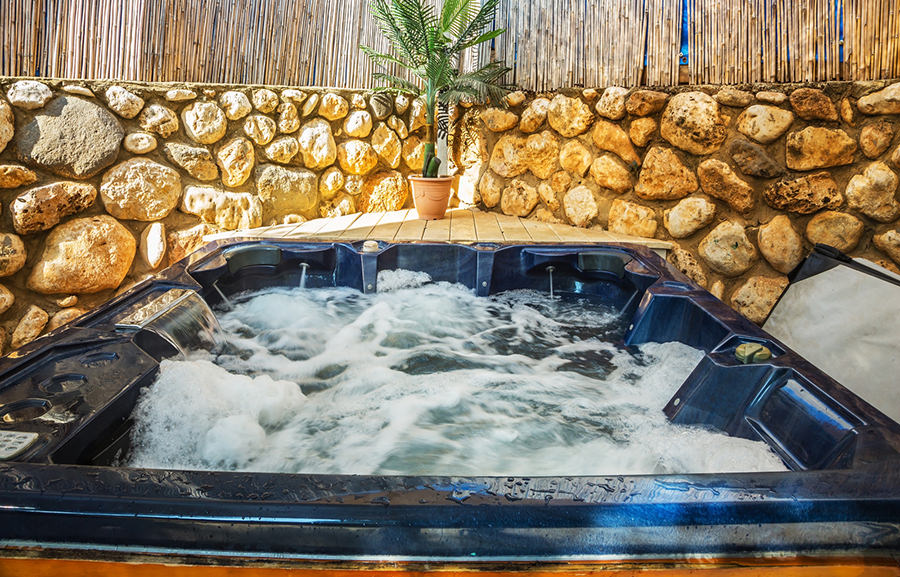
However, despite all this the recommendation from The Center for Disease Control and Prevention is that the only way to be 100% sure that your hot tub is completely clean and fresh is to use either a chlorine or a bromine sanitizer. Personally I would be very tempted to change to the mineral/ ozonator system as my hot tub doesn’t get a huge amount of use and we are pretty much fastidious about showering and being clean before we go in it. But if I have a commercial spa or hot tub then I guess that I would need to follow the recommendations and use a chlorine or bromine – based system.
UV hot tub sanitization – Another alternative to Chlorine or Bromine is to use ultraviolet light sanitisation. In this system, the water is zapped by ultraviolet light and basically anything that gets in the way is killed in the process. Apparently, UV sanitization works extremely effectively but it doesn’t necessarily leave the water particularly clear or fresh. Again, to ensure water clarity and 100% freshness, it is recommended by most UV sanitizer manufacturers that you use a little chlorine as well or at least shock the hot tub on a regular basis. You could, of course, use the UV system in conjunction with a non-chlorine shock which would solve the problem of using the harsh chemical.
UV systems again becoming increasingly popular but there is, as usual, a relatively large outlay at the beginning to convert your tub to the UV system.
Chlorine and Bromine – Traditionally chlorine and bromine have been the most popular chemicals used to keep hot tubs nice and clean. Depending on where you read people tend to say that chlorine is the most popular and in fact a majority of hot tubs will be using a chlorine or bromine system in some way or another. Both chemicals are from the halogen family and are actually quite closely related.
The advantages of using chlorine or bromine are that assuming that you are following the instructions properly and maintaining your hot tub water chemistry accurately, both chemicals are extremely effective at disinfecting water. They have also been used for many years both in hot tubs and pools and they are a well developed and advanced technology. We know exactly how to use them and what results we will get from them. So, to a certain extent, the traditional chlorine or bromine solution is a bit of a safe option.
However, there are drawbacks chlorine, for example, does smell quite strongly and is also well known to irritate both skin and eyes. Some people also get respiratory issues particularly with chlorine but also with bromine as well. Bromine is relatively easy to use but chlorine has to be used in water with an accurate pH level or else it quickly becomes less effective. You also need to regularly top up and check your water level to make sure that you have the right amount of chlorine or bromine in your water. Most commonly bromine is added to the hot tub in tablet form with a floating dispenser in the water and fluorine is just sprinkled onto the water and allowed to dissolve.
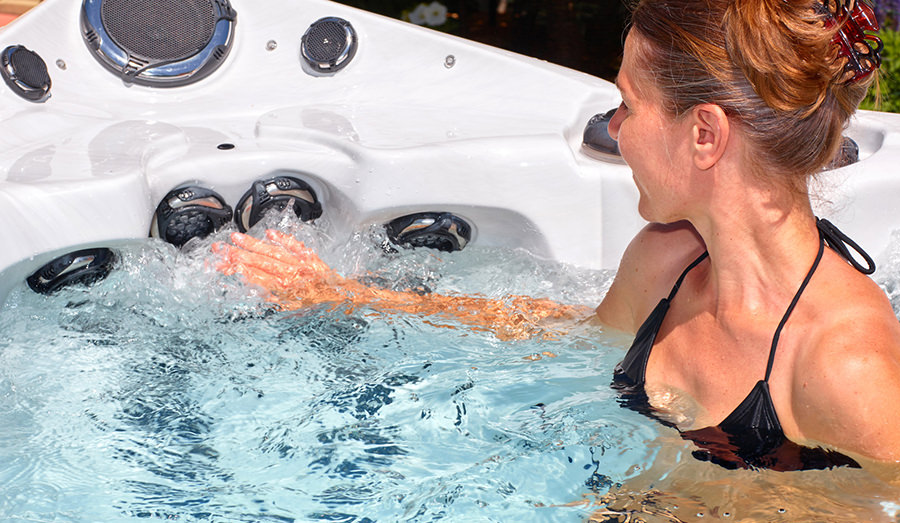
There is also the environmental issue of both chlorine and bromine manufacture and disposal to consider and also you will need to think about your views on disposing of water that has had strong chemicals in it. Not to mention the fact that you may or may not feel happy about yourself and friends and family essentially sitting in a soup of strong chemical. (Have a look at my post about the environmental impact of hot tubs here. ) You will also find that with a chlorine or bromine sanitisation system that there is an ongoing cost. The more the hot tub is used the more chemical will need to be added and these costs do as up.
So, there are a number of pros and cons to the traditional chlorine and bromine system and a number of people, particularly in the last few years, have started to feel that they want to move away from this high chemical and artificial environment. The downside of this is that currently, the advice is that if you are not using either chlorine or bromine you can’t be 100% sure that your hot tub is fully disinfected. However, for a number of people this is a risk worth taking.
For more details on the comparison between chlorine and bromine have a look at my post here
Saltwater Sanitization – Yet another alternative to the more chemical approach is to use a saltwater sanitization system. As you probably know salt is sodium chloride and it’s the chloride part that’s important in this process. Basically, salt is added to the hot tub water so that it becomes a very mild saline solution and then a minute electrical charge is passed through it. This system of electrolysis separates the sodium and chloride out and it’s the chloride or chlorine that then goes on to kill bacteria and keep the water clean.
This system is very popular in high-end hot tubs as it is said to be very environmentally friendly and very cost-effective. The other advantage is that the water quality is extremely high. Because the water has a small amount of salt in it, it becomes very soft when has a really nice feel to it and it looks clean, clear and sparkly as well. Again, maintenance for this system is relatively straightforward and many suppliers of saltwater sanitization systems are claiming that the water only needs to be changed every year or so in your hot tub rather than every 3 or 4 months as you would have to do in a more traditional system.
On the face of it a saltwater sanitisation system seems perfect. It’s said to be environmentally friendly, relatively cheap and the maintenance is low. However, on closer inspection you will realise that you have to regularly change the chlorine generator cells and, depending upon the model, this can be relatively expensive. I’m also not sure whether these used filters can be disposed of in an environmentally friendly way. You will also have realised that actually, we’re still using chlorine clean the hot tub. Of course it’s the more naturally occurring form of chlorine and it’s said to not smell or irritate the skin, but it is still chlorine nonetheless. The other slightly concerning issue with this system is that apparently, the saltwater splashes can mark hot tub woodwork and bodies and also stain decking. It’s also possible that the mild saline solution could corrode any metal parts inside a hot tub that isn’t specially designed to work with salt water sanitization system.
You can read more about saltwater sanitization in my post here.
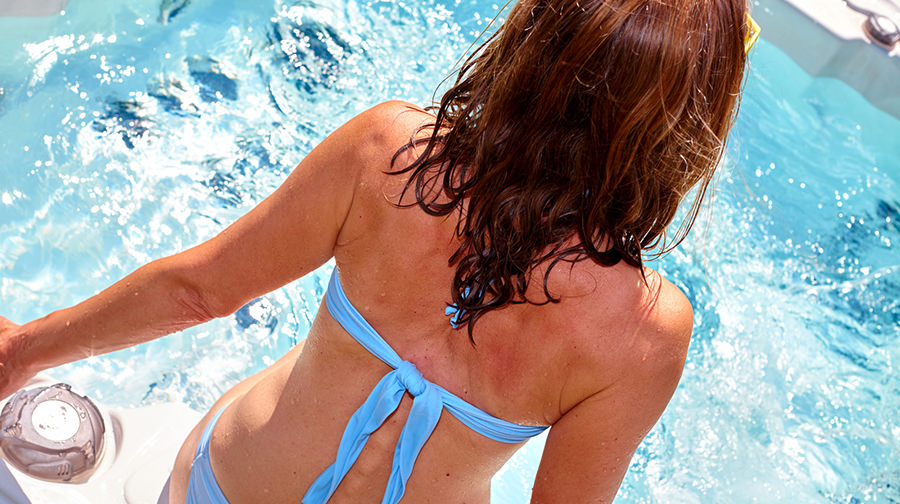
Which hot tub sanitizer is best for me?
This is the big question: which of all of the sanitization methods is the best for you and your hot tub? Well it really depends on your hot tub the amount of use it gets and your priorities.
If I was on a budget and was also a relatively inexperienced hot tub owner then I would probably go for a bromine-based solution. Bromine is highly effective and also most importantly relatively easy to maintain. A bromine system doesn’t have any major outlay at the beginning and the costs are ongoing depending on how much the hot tub is used. If I was buying a new hot tub and had a good budget, but again was relatively inexperienced or really wanted the easiest life, then I would be highly tempted by either a UV or saltwater system.
However, it may not be as straightforward as that. What if you are currently using a chlorine or bromine system and you are finding that it is irritating your skin or you are simply not happy sitting in a chemical solution? In that case I would probably look carefully at a saltwater conversion and look forward to the quality of water that it could potentially produce.
However for me, I think the current best solution would be to go for the mineral and ozonator combination and try to use that with a non-chlorine shock. I’m not 100% sure that this would work for a very high usage hot tub but for the amount of use that mine gets I think it would be worth giving it a try. This system would be a good compromise and most importantly to me, I would be avoiding the unpleasant experience of sitting in a bath of chemicals. At the very least, if using a non-chlorine shock didn’t really work out I could have a small amount of chlorine in and rely on on the mineral and ozonator to do most of the work. At least I would know that I was using the minimum amount of chlorine possible to keep the hot tub clean.
Should I convert my hot tub to a different sanitizer?
Finally, you need to carefully consider the pros and cons of actually converting your hot tub to use a different sanitiser. In some instances, this is relatively straightforward but for other conversions, it may well not be. For example, if you are changing from bromine to chlorine then essentially all you need to do is a very thorough drain and clean of the hot tub before starting again with the new sanitiser.
If you are considering changing from a chlorine or bromine sanitization system to maybe a UV system then you have to be very aware of the cost implications of this as the UV system will most probably need to be fitted into your hot tub by a technician. If you have a relatively new hot tub you will need to check to see if this might invalidate your warranty.
If you are thinking of changing to a saltwater system you would also need to check that your particular hot tub is capable of running a saltwater sanitisation system. You could damage the internal parts of your hot tub and they could corrode in the saltwater. Again changing to a saltwater system with a hot tub that is still in warranty could potentially invalidate that warranty.
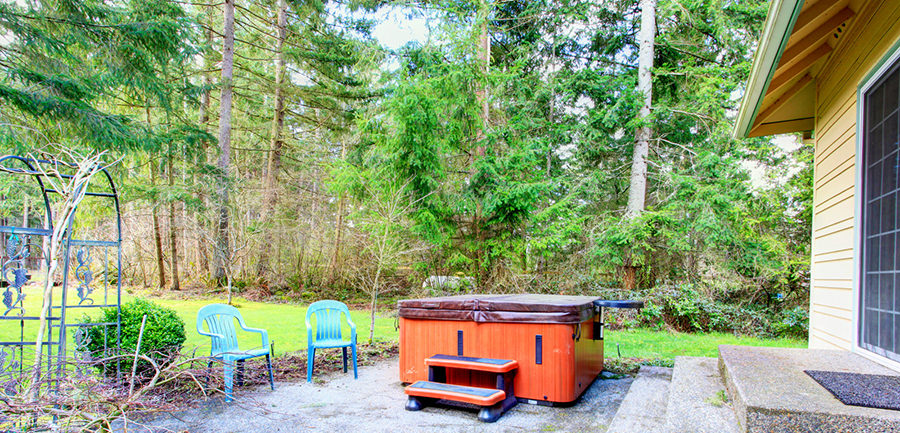
So, the best advice is that if you have a hot tub that is still in warranty then the best thing is probably to speak to your hot tub supplier to see if it’s possible for them to advise you and change the sanitization system and not compromise your warranty agreement.
If you have an older hot tub or a hot tub that doesn’t have a warranty then you have a few more choices. There are relatively simple saltwater systems for example that you simply hang in the water and require very little in the way of setting up or maintenance. There’s no reason why you can’t change to using an ozonator and mineral system or even consider adding a UV sanitizing system yourself.
Summary
It’s not possible to answer the question of what is the best sanitizer. It will all depend upon your personal priorities and points of view. The best and most effective sanitizers are chlorine and bromine and if you want a relatively cheap solution, and one that at will do a fantastic job then this is the way to go. However, if you find either chlorine or bromine unpleasant or just don’t like the idea of using them then you could consider using a mineral and ozonator system or possibly a UV or saltwater system as well. All have their pros and cons as outlined above but in a majority of cases you will probably find that you need to at least supplement with some chlorine at some point.
Whichever sanitization solution you go for be careful to read the instructions extremely carefully and to make sure that you keep up with ongoing maintenance. No sanitizer will do it job effectively if it’s not applied correctly and you run the risk of your water becoming unpleasant and cloudy, or in some cases harbouring disease and bacteria as well. Sanitizers do a vital job so it’s important that you make your choice carefully.
Related Questions:
Do I need to shower after using the hot tub? – It can be a great idea to shower after using a hot tub to make sure that you have removed any bacteria or algae from your body. Similarly, showering before you go into the hot tub removes soaps, conditioners, shampoo and other bodily dirt and grime that significantly impacts on the cleanliness and water quality of the hot tub.
What happens if I put too much chlorine in my hot tub? A hot tub with high chlorine levels will possibly create skin irritation and also smell. You need to wait until the chlorine has reduced to a safe level before getting into the hot tub. You can measure the amount of chlorine in your hot tub water using a water testing kit.

